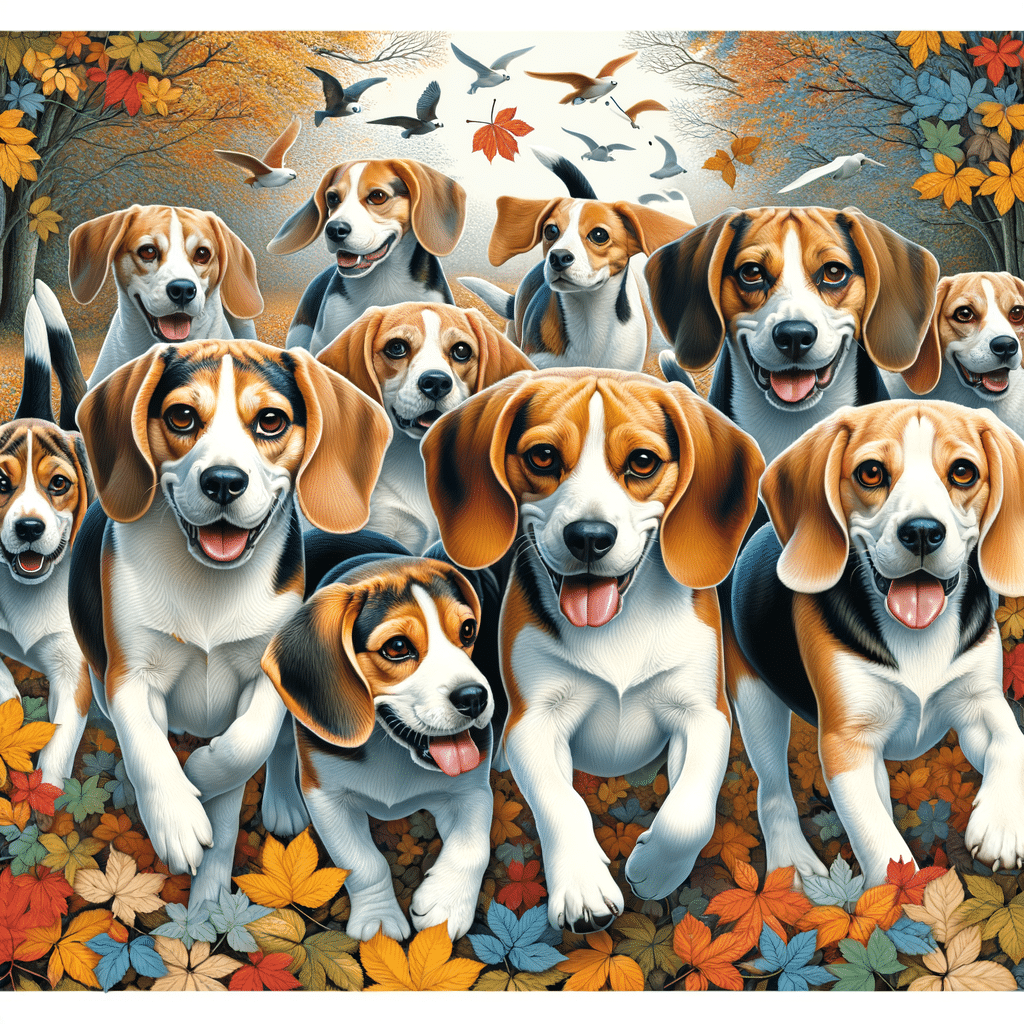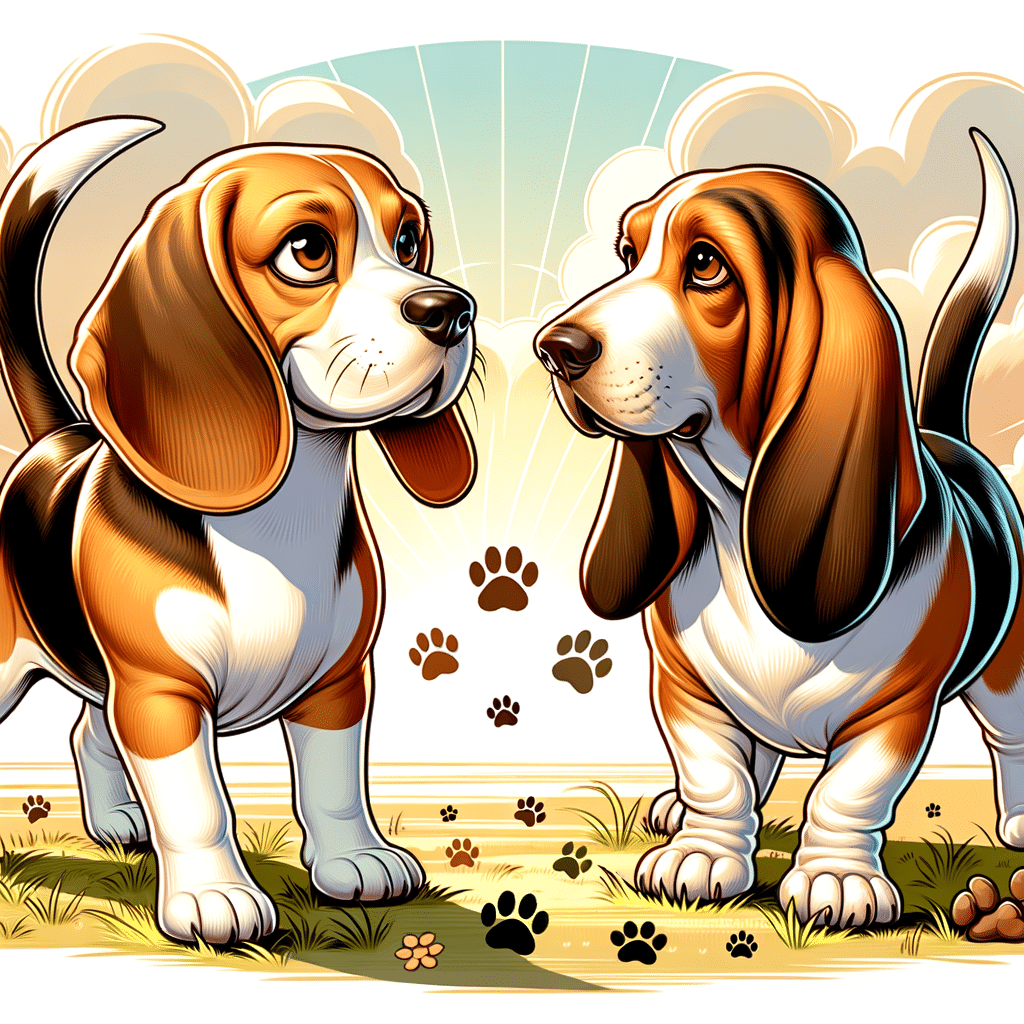Potential dog owners might compare the beagle to the Walker hound when considering a canine companion. Both breeds have a storied history, with the beagle tracing its lineage back to England and being renowned for its strong sense of smell and compact size.
In This Article
The treeing Walker coonhound, a distinctly American breed more commonly known as the Walker hound, also possesses a powerful nose but is larger and typically more streamlined than the beagle.
Both breeds are tenacious and energetic scent hounds, making them exceptional hunting partners and active family pets. The beagle, known for its friendly disposition and melodic bark, is smaller than most hounds, making it more suitable for families with limited space.
On the other hand, the Walker hound is praised for its powerful hunting instincts and unmatched endurance in the field. While both breeds share a common hunting heritage, their individual physical and temperamental characteristics offer different experiences as pets.
Highlights
- The beagle is smaller and has a friendly disposition compared to the larger Walker hound.
- Both beagles and Walker hounds are highly valued for their hunting prowess and endurance.
- Both breeds require sufficient exercise and can make excellent companions due to their inherent social nature.
Breed Characteristics and Comparison
When comparing the beagle and the Walker hound, it is important to consider their origins, physical traits, behavior, health, and suitability to different living environments to understand each dog breed’s uniqueness and requirements.
Origin and History
The beagle originated in England and has a history as a scent hound used for tracking small game. Walker hounds, developed in the United States, descend from the English foxhound, and were bred to hunt by scent and tree small game.
Physical Attributes
Beagles are small to medium-sized dogs with a height of about 13-15 inches and a weight range from 20 to 30 pounds. They have a short, hard coat, often in tricolor. The Walker hound is larger, standing 20 to 27 inches tall and weighing 50 to 70 pounds, with a smooth, glossy coat that comes in black, white, and red.
Temperament and Behavior
Beagles are known for their friendly and playful nature, making them a suitable dog for families. They are energetic but can adapt to calmer environments. The Walker hound is also friendly but has a stronger working drive, showing a calm temperament only once adequately exercised.
Health and Lifespan
Common health problems for beagles include obesity and epilepsy, with a life expectancy of 10-15 years. Walker hounds may experience issues like hip dysplasia or eye conditions, including progressive retinal atrophy that eventually leads to blindness. Regular eye examinations can help manage these risks. Their lifespan is typically 12-13 years.
Adaptability
Beagles can adjust well to apartment living as long as they receive sufficient exercise. In contrast, due to its size and energy level, the Walker hound performs best with access to larger spaces and may be more prone to escaping enclosures in an attempt to wander or go hunting on its own.
Breed Popularity
The American Kennel Club (AKC) ranks the beagle consistently high in breed popularity. Walker hounds are lower in popularity but well-regarded among hunting-dog sport enthusiasts in the USA.
Care and Training Requirements
Both dog breeds require regular exercise and respond well to training due to their high intelligence levels. Beagles may require more patience in training, while Walker hounds are eager to please and learn quickly. Both have moderate grooming needs, focused on routine brushing and occasional baths.
Cost and Availability
The price for beagle puppies varies widely but is generally between $300 and $1,200. Walker hound puppies might be found for $600 to $800. Both breeds’ costs can be influenced by lineage, availability, and breeder reputation.
Breed-Specific Concerns
When comparing the beagle with the Walker hound, it’s essential for potential dog owners to consider each breed’s unique health issues, training challenges, care needs, and behavioral traits to provide them with the best quality of life.
Common Health Issues
Beagles and Walker hounds share some genetic predispositions that prospective owners should watch for. Both breeds can suffer from hip dysplasia, a malformation of the hip joint, and eye conditions like progressive retinal atrophy, which could potentially lead to blindness. Regular eye examinations are recommended to catch any issues early on.
- Beagles may experience problems like obesity, ear infections, hip dysplasia, eye conditions, and epilepsy.
- Walker hounds may have allergies, hip dysplasia, eye conditions, and ear infections, primarily due to their large, floppy ears.
Training Challenges
Trainability can differ significantly between the breeds. While beagles are amongst the smartest dog breeds, they are often not seen as the most obedient due to their independent nature. Consistency and patience are vital in training them. On the other hand, Walker hounds are highly trainable, showcasing their intelligence and eagerness to follow commands.
- For novice owners, beagles might present a challenge due to their stubbornness.
- Walker hounds, with early training, can be a good match for less-experienced owners, given their higher sensitivity level and desire to please.
Care Needs
Their care needs for grooming and exercise are relatively easy to manage but cannot be neglected.
- Beagles are generally easy to groom, thanks to their short coat.
- Walker hounds require a bit more attention due to their size but still fall into the easy-to-groom category.
Both breeds need regular, adequate exercise to prevent obesity, a common health issue. Their diet should also be monitored to maintain their ideal weight.
Behavioral Traits
Personalities between beagles and Walker hounds are distinct, reflected in their behavioral traits.
- Beagles are known for their playfulness, friendliness, and stubbornness.
- Walker hounds have a strong prey drive and are highly likely to chase due to their hunting heritage from England.
Both breeds are not typically found on any guarding or guard dog breeds list, as they exhibit low territorial behaviors. However, they bring different dynamics to home, from the Walker hound’s alert temperament to the beagle’s social and gentle nature.
Frequently Asked Questions
This section addresses common inquiries regarding comparing beagles and Walker hounds, focusing on their temperament, size, suitability as house pets, genetic similarities, and characteristics of their mixes.
What is the difference in temperament between a beagle and a Walker hound?
Beagles are known for their friendly and curious nature, making them excellent family pets. Walker hounds, particularly the treeing Walker coonhounds, are more intense and driven, bred for their hunting prowess, which often translates to a higher energy level.
How do the sizes of beagles and Walker hounds compare?
Beagles are smaller dogs, usually 13-16 inches tall and weighing up to 30 pounds. In contrast, Walker hounds are larger, with treeing Walker coonhounds standing 20-27 inches and weighing 50-70 pounds.
Can Walker hounds, which are often confused with beagles, make good house pets?
Walker hounds can make good house pets for active families that can meet their exercise needs. They are intelligent and trainable but require sufficient mental and physical stimulation due to their hunting heritage.
Are beagles genetically similar to any coonhound breeds?
Beagles are a distinct breed but share a common ancestry with other hounds, including various coonhound breeds, as they are all part of the hound group with a history of hunting.
What are the characteristics of a beagle-coonhound mix?
A beagle-coonhound mix would likely exhibit common dog behavior from both breeds, such as a strong sense of smell, a tendency to vocalize, and an active disposition. They would require plenty of exercise and firm, consistent training.
Do Walker hounds tend to bark more than beagles?
Walker hounds are more vocal. Beagles can also be vocal but bark less frequently than the Walker hounds.






